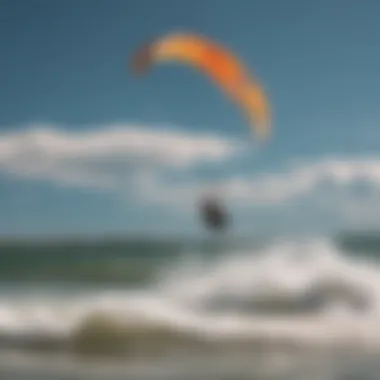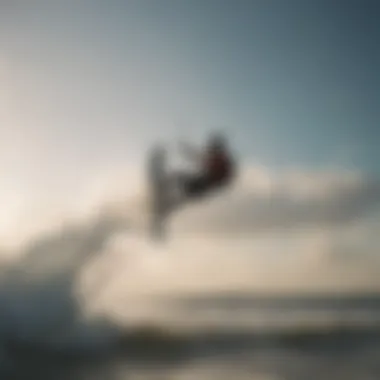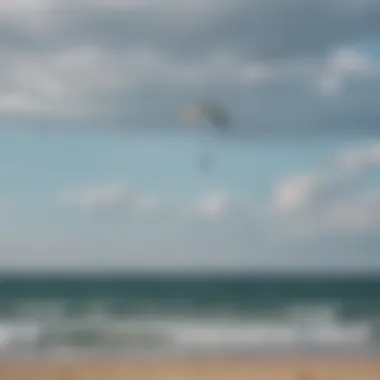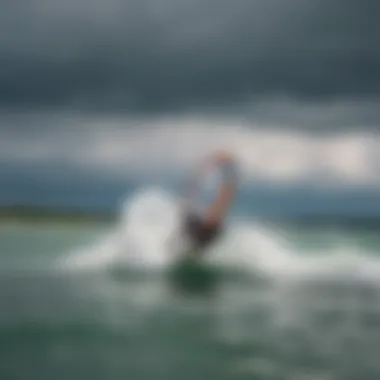Mastering Kitesurfing Weather Dynamics in Traverse City


Intro
Kitesurfing in Traverse City is not just a sport; it is a blend of art and science, particularly when influenced by its unique weather patterns. As enthusiasts seek to harness their skills on the water, understanding the complexities of local conditions—temperature variations, wind behavior, and seasonal phenomena—becomes essential. This guide will provide insight into these intricate dynamics to foster a more rewarding kitesurfing experience.
As adventure seekers know, the success of each kitesurfing session hinges heavily on wind conditions and weather forecasts. The interplay between seasonal trends and daily weather patterns establishes the ideal environment for riders to pursue their passion. When armed with such knowledge, kitesurfers can better prepare themselves for the challenges presented by Mother Nature.
At the heart of kitesurfing is precision, and this extends from understanding conditions to maintaining equipment and employing diverse techniques. Hence, this article will not only delve into weather complexity but also cover essential gear reviews and safety protocols to enhance safety on the water.
Each section is designed to enrich your awareness and enhance your confidence while handling various elements in the adventurous realm of kitesurfing.
Preface to Weather Dynamics
The dynamics of weather play a significant role in kitesurfing, particularly in a region like Traverse City. Understanding the weather conditions can mean the difference between an exhilarating, successful day on the water and a frustrating, even perilous experience. An informed kitesurfer is better equipped to choose the most favorable times for riding.
Kitesurfing relies heavily on factors such as wind direction, speed, and temperature. Each of these elements impacts safety and performance. Consequently, it is crucial for enthusiasts to gain knowledge about specific patterns and characteristics in Traverse City.
Important aspects to consider include the interplay of seasonal shifts, local geographic features, and climatic influences. By examining these elements, riders can enhance both their skills and comfort on the water.
The Importance of Weather in Kitesurfing
Weather is an essential element in kitesurfing, as it creates the foundation for optimal conditions. Many advanced riders connect kite performance directly to their understanding of local weather patterns. On a fundamental level, knowledge about wind direction directly affects how a rider propagates across the water's surface.
Lately, understanding blow during inclement weather is vital. Unpredictable turbulecne or shifts in wind strength can jeopardize both safety and enjoyment. Adverse weather can lead to critical situations, depending on the rider’s level of expertise.
Furthermore, a keen sense of reading weather conditions aids not only in planning surfing outings but also builds a systematic approach to identify safe zones. Knowledge provides the following benefits:
- Enhanced Decision Making: Better choices based on environmental cues.
- Improved Skill Development: Over time, each ride informs future sessions based on weather knowledge.
- Maximized Enjoyment: Good weather leads to good vibes and fun surf sessions.
Overview of Traverse City as a Kitesurfing Location
Traverse City is well-regarded among kiteboarders for its unique weather patterns and reservoir options for riding. The region experiences diverse weather characteristics influenced by topography and its proximity to Lake Michigan. This location creates a distinct opportunity for enthusiasts to ride under varying conditions.
Several factors contribute to making Traverse City a premier kitesurfing destination:
- Consistent Winds: The area frequently showcases winds conducive to kitesurfing. Both novice and experienced kitesurfers thrive here.
- Varied Locations for Riding: Numerous spots such as Clinch Park and Bowers Harbor provide refuges suitable for kiting.
- Rich Kitesurfing Community: A vibrant local scene supports riding events and promotes ongoing learning opportunities.
These elements shape a comprehensive backdrop for kitesurfing in Traverse City. Thus, enthusiasts excited by improved skills can greatly benefit from both established practices and awareness of local weather dynamics.
Seasonal Weather Patterns
The impact of weather on kitesurfing cannot be overstated. Different seasons bring unique patterns that can directly affect the conditions on the water. Understanding these seasonal variations allows kitesurfers to maximize their time on the water and make informed decisions regarding their outings. Various factors such as wind speed, temperature, and local meteorological conditions influence the experience throughout the year. Thus, being adept at reading these patterns is beneficial for both safety and enjoyment.
Spring Weather Characteristics
In Traverse City, spring marks a transition from the cold winds of winter. From March to May, temperatures slowly rise, creating conditions that are favorable for kitesurfing. Winds during this period often show variability in strength and direction, usually influenced by frontal systems and changes in temperature. Spring winds often range from 10 to 15 knots, which are optimal for beginners and experienced kitesurfers alike.
During early spring, water temperatures remain low due to melting ice and snow. Kitesurfers should take care to wear suitable wetsuits to counteract the chill and prevent hypothermia. The occasional rain showers are common, so checking for sudden weather changes is essential before heading out. Overall, spring provides an excellent opportunity to get back onto the water after winter.
Summer: Peak Kitesurfing Season


Summer season in Traverse City, spanning June to August, is the prime time for kitesurfing. Characterized by consistent winds and warmer air and water temperatures, summer attracts many athletes and enthusiasts. Wind patterns tend to stabilize during this period, with sustained winds typically ranging from 12 to 20 knots.
The presence of local thermal effects, caused by temperature differences between land and water, often enhances wind strength in the afternoons. This is the time when many riders take to the waters, especially during weekends. Safety should not be overlooked here, though. Watch for local weather systems that can churn up fast storms in the afternoons. Be aware of water conditions and ensure compatible equipment is used, enhancing the overall safety and thrill of the kitesurfing experience.
Autumn Weather Trends
As summer fades into fall, the kitesurfing landscape also alters considerably. September to November present transitional weather patterns. Winds may generally be stronger during this season, with frequent fronts moving in. Wind speeds typically range between 10 and 25 knots.
Although temperatures are starting to drop, particularly in water, fall often brings sunny, clear days, which makes for beautiful kitesurfing conditions. However, the fall can be unpredictable, and caution should be applied when planning outings. Kitesurfers should be mindful about what kind of gear is suitable during this period, particularly considering advancing hypothermia risk as temperatures plummet. Autumn can indeed present some great opportunities for quality kitesurfing.
Winter Weather and Kitesurfing Options
Winter kitesurfing in Traverse City is not as popular, but it is an option to consider. From December to February, both the air and water temperatures drop. During this season, ice conditions will largely determine the viability of kitesurfing. If conditions permit, kitesurfers might engage in ice kiting on frozen lakes.
Wind patterns in winter can be more consistent, and wind speeds may vary from 15 to 30 knots, offering some thrilling experiences for the well-prepared. Dressing adequately becomes crucial; winter kitesurfers must have appropriate cold-weather gear that keeps them warm while maintaining mobility.
Wind Patterns in Traverse City
Wind is an essential element for kitesurfing. For riders in Traverse City, understanding wind patterns can significantly enhance their experience. This section discusses several key components related to wind dynamics in this region.
Understanding Local Wind Patterns
Traverse City is notable for its diverse wind patterns. The area's geographical features, including Lake Michigan, influence these patterns profoundly. Local topography, such as hills and valleys, also affects how winds travel. Moreover, certain times of the year show reliable wind directions and speeds that are preferred by kitesurfers.
Kitesurfers often notice stronger winds during the spring months, resulting from atmospheric changes as winter concludes. When considering local wind patterns, one needs to think about several factors:
- Temperature variations: Seasonal temperature changes create different pressure systems that lead to varying winds.
- Geographical influence: Being near large bodies of water often leads to a discrepancy in local wind conditions compared to inland areas.
Knowing the frequent wind conditions at specific beaches can help you make better choices about when and where to kite.
Directional Influences on Kitesurfing
The direction of the wind significantly impacts kitesurfing. Traverse City experiences wind from several directions, with northwest and southeast being the most common. A northwest wind pushes nicely across large open spaces, allowing for excellent launching and riding conditions. Conversely, a southeast wind can introduce unpredictable gusts due to the nearby hills and buildings, making it essential for kitesurfers to adapt quickly.
Riders should consider the following when analyzing wind direction:
- Launch and Safety Zones: Understanding wind-shaped terrains help in finding appropriate launch sites.
- Wave Formation: Wind direction often dictates wave size and formation, crucial factors for specific types of tricks.
Choosing a specific direction correlates with personal skill levels. Start with areas where the wind is consistent and predictable, especially if you're newer to the sport.
Wind Speed and Its Impact on Kitesurfing
Wind speed directly affects kitesurfing performance. For enthusiasts in Traverse City, optimal wind speeds range between 12 and 25 mph for most kitesurfing activities. Lower wind speeds may not provide enough lift for beginners or smaller kites. Conversely, wind speeds above 25 mph can present dangerous conditions for less experienced riders.
Riders should always monitor wind conditions before heading out:
- Kite Size Adjustments: As wind speed increases, riders may need to scale up the size of their kites. Failing to do so could make control more difficult.
- Physical demands: Stronger winds require more energy from the rider, impacting endurance. Understanding this helps in planning sessions more efficiently.
Temperature Norms and Their Effects
Understanding the temperature norms in Traverse City is crucial for kitesurfers aiming to optimize their experience on the water. Temperature influences various factors, including air temperature, water temperature, and overall conditions for riding. Riders must be aware of how these temperature variations impact both their performance and safety.


Typical Temperature Ranges by Season
In Traverse City, the seasonal temperature variations can significantly affect kitesurfing conditions.
- Spring: Temperatures generally range from 40°F to 60°F. This transitional period can experience rapid shifts, which is important for riders to note, as equipment adjustments might be necessary.
- Summer: The peak season sees warmer temperatures averaging between 70°F to 85°F. Such conditions are optimal for kitesurfing, as water conditions also improve, enticing both beginners and experienced riders.
- Autumn: The temperatures begin to dip again, ranging from 45°F to 65°F. While conditions remain generally favorable, riders need to be cautious as sudden cool fronts can arise, altering water behavior and safety considerations.
- Winter: With temperatures often below 32°F, this season poses challenges for kitesurfing. However, some specially trained riders may take advantage of frozen water surfaces depending on personal willingness and readiness.
How Temperature Influences Water Conditions
Temperature not only affects air quality but also deeply influences the water. As water temperatures fluctuate, so do various metrics important for kitesurfers.
- Water Temperature Effects: Colder water can lead to less comfort and even hypothermia if safety protocols aren’t followed. Wet suits are essential for temperatures below 60°F, ensuring heat retention while kitesurfing.
- Current Movement: Warmer water usually results in more viscous currents. This effect must be noted. Kitesurfers should stay alert, as these can create challenging riding conditions.
- Fog Formation: In spring or fall, warmer water combined with cooler air temperatures can cause fog. Reduced visibility during kitesurfing can prove to be a safety hazard.
Understanding Temperature’s role in kitesurfing ensures safe, enjoyable rides in Traverse City.
Overall, it's imperative for athletes to consider these temperature norms while planning kitesurfing activities. Adapting riding practices to specific temperature ranges maximizes both performance and enjoyment.
Local Meteorological Phenomena
Local meteorological phenomena play a crucial role in shaping kitesurfing conditions in Traverse City. Understanding these unique weather events can greatly enhance the experiences of riders, allowing them to make informed decisions about when and where to kite surf. Notably, the region's geographic features interact intricately with atmospheric conditions, giving rise to certain weather patterns that are specific to this area.
Such phenomena can influence everything from wind speeds to water temperatures. They can create opportunities for ideal kitesurfing conditions, but can also pose risks if not fully understood. Therefore, gaining insights about local meteorological phenomena is essential for any kitesurfer looking to navigate the waters safely and efficiently.
Lake Effect and Its Impact on Weather
The lake effect is a significant factor in the weather dynamics of Traverse City. This phenomenon occurs when cold air moves over warmer lake water. As the air interacts with the warmer water, it gains moisture and heat.
The results of this interaction often manifest as increased wind speeds in the vicinity of the lake. For kitesurfers, such conditions can translate to enhanced riding opportunities when the right wind direction aligns with the air flow. However, this effect also carries potential dangers.
It's crucial to keep an eye on local forecasts that account for lake effect dynamics. Some ways to do this include:
- Check for changes in wind patterns close to the lake.
- Pay attention to temperature variations that signal a change in air quality.
- Understand the influence of nearby land formations which can affect the winds.
Storm Systems and Safety Concerns
Storm systems are another consideration for kitesurfers in Traverse City. They can move into the region quickly, bringing with them changes in weather conditions that require vigilance. Tighter pressures, storm fronts, and shifting winds lead to rapid fluctuations in what might be safe for kitesurfing.
Common storm-associated challenges include:
- Wind Change: Sudden shifts in wind direction and intensity can upset riding conditions.
- Lightning: Outdoor activities during stormy conditions should always account for potential electrical hazards.
- Localized Heavy Rain: This can lead to rough water and unexpected currents.
Being aware of weather radar data, or using specialized weather apps designed for outdoor activities, can provide critical alerts about incoming storms. Each kitesurfer should prioritize their personal safety by planning around these local storm systems and ensuring they have the necessary safety gear.
In summary, local meteorological phenomena such as the lake effect and incoming storm systems present both opportunities and challenges. Staying informed not only helps handle the complexities of kitesurfing conditions, but also enhances safety.
Best Practices for Kitesurfing Based on Weather Insights
Kitesurfing requires a precise understanding of weather dynamics. The right conditions can make the difference between a thrilling ride and a dangerous experience. Knowledge is key for successful kitesurfing sessions in Traverse City, known for its changing weather and local conditions.
Planning Your Kitesurfing Sessions
To get the most from kitesurfing, careful planning of sessions is critical. Riders should start by checking forecasts that specifically cover local wind speeds and directions, temperature, and possible weather systems. Here are crucial factors to consider:


- Wind Speeds: Ideal wind speed usually ranges from 12 to 25 knots for kitesurfing. Go over forecasts to establish when these conditions may occur. Too low or too high wind can jeopardize your control of the kite.
- Local Patterns: Familiarize yourself with patterns specific to Travers City. Gather information on local vibes that may affect any predictions. For example, during lake effect snow seasons, winds can change suddenly.
- Timing: Stay aware of timing, especially at dawn and dusk. Winds often vary and knowing peak wind times can enhance your experience. Condition changes happen quickly.
Riders are encouraged to jot down historical weather conditions to understand average patterns for their preferred months. This aids in selecting the best times of year or day to maximize performance and safety.
Utilizing Weather Apps for Predictions
With technology’s advance, weather apps have become essential for kitesurfing enthusiasts. Reliable weather applications offer live updates, allowing kitesurfers to adapt to changing conditions in real time.
When selecting a weather app, prioritize features that align with kitesurfing needs:
- Wind Alerts: Look for apps that can send push notifications to alert you when wind conditions are ideal. These alerts can prevent wasted trips.
- Radar Maps: Weather apps should include radar maps to visualize conditions directly. Being aware of approaching storms helps avoid sudden weather changes.
- Community Insights: Apps often have sections where users share their experiences related to specific weather conditions that can give amateur enthusiasts extra insight.
Regular use of such innovations can sharpen your instincts about the possible weather changes, empowering kitesurfers to make wiser, more informed decisions.
By harnessing inspired practices from nimbly adapting to nature's whims, kitesurfers align their experience with the unique weather conditions of Traverse city.
Safety Considerations in Variable Weather
Safety is paramount in kitesurfing, especially in an area like Traverse City where weather can change unexpectedly. This section emphasizes why it’s essential to be vigilant about meteorological conditions. Success in kitesurfing hinges as much on skill as it does on understanding those dynamics that can impact safety.
Kitesurfers are often at the mercy of wind changes, temperature shifts, and unforeseen weather events. By recognizing these variables, enthusiasts can make informed decisions about when to hit the water. Emphasizing safety provides the kitesurfing community with critical insights into possible perils and how to navigate in unpredictable circumstances.
Recognizing Dangerous Weather Conditions
Understanding when not to venture into the water is crucial for kitesurfers. One should watch for the following hazard signs:
- Sudden Wind Changes: An abrupt shift in wind direction or speed can indicate an approaching storm or front.
- Darkening Skies: A mere change in cloud color or formations can denote incoming rain, which often brings stronger winds.
- Prolonged Calm Periods: Extended lulls in activity can usually precede sudden, gusty winds later.
It's key to employ an awareness of conditions that may not be immediately obvious. Always consult local forecasts and regularly observe signs in your environment. When these indicators show, it's safe to understand that staying out of the water ensures anybody’s safety.
"Wisdom in kitesurfing involves knowing not just when conditions are right, but also when they become dangerously wrong."
Safety Gear Recommendations
To ensure a safer kitesurfing experience, using appropriate safety gear cannot be overemphasized. Here are some crucial items that you should consider:
- Personal Flotation Device (PFD): A well-fitted PFD can greatly enhance safety, providing buoyancy in case of water immersion.
- helmet: This piece protects the head during unplanned falls, providing essential support in managing impacts from the water or other hazards.
- Safety Leashes: A helm near your leash connection can keep the kite tethered, preventing runaway scenarios from overweight lines.
- Communication Device: Having a waterproof device like a VHF radio can assist in reaching help in emergencies or connect with companions on the water.
Analyzing environmental elements alongside employing the right safety gear creates a safer and more enjoyable kitesurfing experience for all. Thus, proper mill your kit before you ride.
Finale
The discussion aroudn kitesurfing in Traverse City cannot be complete without emphasizing the weather dynamics. Understanding the complex relationships between different weather conditions is crucial. It not only helps kitesurfers plan better but also enhances their overall surfing experience.
Summary of Key Weather Considerations
To kitesurf effectively in Traverse City, you must be mindful of several critical weather factors:
- Wind patterns: Locally dominateg winds dictate when kitesurfers should head out. Grasping their direction and intensity is necessary for ensuring a successful session.
- Seasonal variations: Keep track of how the seasons fluctuate in temperature and wind. This knowledge allows you to choose the right gear.
- Safety measures: Adhering to safety protocols will help avoid dangerous conditions that can occur suddenly.
Kitesurfers should consistently check their favorited weather sources like NOAA and meteorological apps for forecasts to maintain uptodate awareness. Consistent monitoring leads to smarter decision-making on and off the water.
Final Thoughts for Kitesurfing Enthusiasts
For kitesurfers in Traverse City, intelligence about weather dynamics greatly increases enjoyment and impacts performance. Taking a comprehensive approach to analyzing the weather will open doors to better sessions. Stay informed, recognize patterns, and be prepared for sudden changes. This proactivity is the difference between becoming a learner and becoming accomplished in this thrilling sport.
Natural unpredictability plays a significant role in kitesurfing, yet anticipation drawn from weather patterns cultivates skill and awareness to master every wave and gust.







